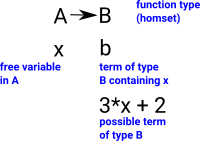A function type is sometimes called an exponent type. This is related to the way we usually use the term 'exponent' in algebra, for example in sets, the number of mappings from A to B is given by the number of elements in B to the power of the number of elements in A.
Notation
| A->B or BA | The function type is denoted A->B or BA. The second tents to be used for exponents in category theory. | |
| λ x . b(x) | A function ( x -> b(x)) can be notated using lambda symbol: λ x . b(x) using '.' to seperate input parameter from output. | |
| M[x/N] | Substitution The expression M in which every x is replaced by N |
Function Type
| In type theory a function type can be constructed from(deconstructed to) an expression. |  |
This requires the concept of substitution.
Usually defined as a 'negative type', that is we define it by how it is used (applying a function).
We can think of the type A->B as either,
- All the possible functions from type A to type B (a homset).
- Object of type B parameterised by an variable of type A.
I find it easier to understand the introduction and elimination rules in terms of the second interpretation.
| To introduce a term of type A->B we need a free variable in A and a term of type B containing x. |  |
Rules
Types are defined by their formation, term introduction, term eliminator and computation rules:
Function Type |
|||||||
|---|---|---|---|---|---|---|---|
formation rule Given any two types A and B we can form a function type A->B |
|||||||
term introduction rule assume a implies b (given a proof of A we get a proof of B) |
lambda abstraction:
|
||||||
term eliminator Modus Ponens |
application:
|
||||||
computation rule substitution - in this case of a for x. |
( λ x . b(x)) (a) ->β b(a) we reduce this by substitution. b[a/x] |
||||||
Local completeness rule eta reduction rule |
M:A->B ->η λ x. M x | ||||||
So function terms are introduced using the lambda abstraction. This is a binder which captures a variable (see lambda calculus page).
We eliminate a function term by applying it. In logic this is known as 'modus ponens' that is: given A and a function from A to B we can imply B.
So the term introduction rule binds a variable and the term eliminator removes that variable.
β-reduction and η-reduction
| An element of A->B can be represented as λ a.Φ | λ a.Φ : A->B |
β-reduction The second form allows us to change the name of the variable by substitution. Replaces a bound variable in a function body with a function argument - inlining. |
(λ a.Φ) a = Φ (λ a.Φ) x = [a/x]Φ |
| η-reduction | f = (λ x . f(x)) |
β Reduction
|
Function evaluation is called β-reduction. This is done by substitution. |
β Equality
Two terms are β-equal is one β-reduces to the other one.
M =βN
if there are terms M0 to Mn such that M0![]() M, Mn
M, Mn![]() N and for all i such that 0 ≤i<n
N and for all i such that 0 ≤i<n
either: Mi =βMi+1 or Mi+1 =βMi
β-Normal Form
- M is in β-normal form if M does not contain any redux
- M is weakly normalising if there is an N in β-normal form such that M -> βN
- M is strongly normalising if there are no infinite reduction paths starting from M
Idris Examples
| Constructor | constructExp : Int -> String constructExp = \ x => prim__toStrInt x |
*typeTheory> constructExp \x => prim__toStrInt x : Int -> String |
| Deconstructor | applyFn : (t1 -> t2) -> t1 -> t2 applyFn f v = f v |
*typeTheory> applyFn prim__toStrInt 3 "3" : String |
Implemetations of Function Type
Idrisfrom : Idris-dev/libs/prelude/Prelude/Basics.idr |
||| Function application. apply : (a -> b) -> a -> b apply f a = f a |
We can implement in Idris like this:
We create anominous lambda like this and apply it like this. |
Idris> \x => prim__toStrInt x \x => prim__toStrInt x : Int -> String Idris> (\x => prim__toStrInt x) 3 "3" : String |
Logic
In logic this structure corresponds to 'implication'.
There is an interpretaion of type theory (known as Curry-Howard) that has the same structure as intuitional logic. In this interpretation an element (term) of a type is a proof of that type.
| Implication is a bit like taking a whole rule, putting brackets round it and using it as a premise for another rule. |
Implication and Modus Ponens
This is discussed further on the propositional logic page.
| Introduction | Elimination | ||||||||
|---|---|---|---|---|---|---|---|---|---|
| (modus ponens) | |||||||||
|
|
Alternatively we can represent modus ponens using context (![]() ) as follows:
) as follows:
|
λ-calculus
(see page here)
Here is a reminder of the notation:
| lambda | variable | dot (separator) |
expression |
| λ | x | . | 2*x+1 |
Note: although I have used an arithmetic expression above, λ-terms are usually defined in a more abstract way, in the extreme case every term is a function.
T ::= V | (T T) | (λV.T)
where
- V is a variable (a symbol taken from an infinite set of symbols).
- (T T) juxtaposition is function application, different from T(T) notation.
Next Steps
Other types are discussed on the following pages: